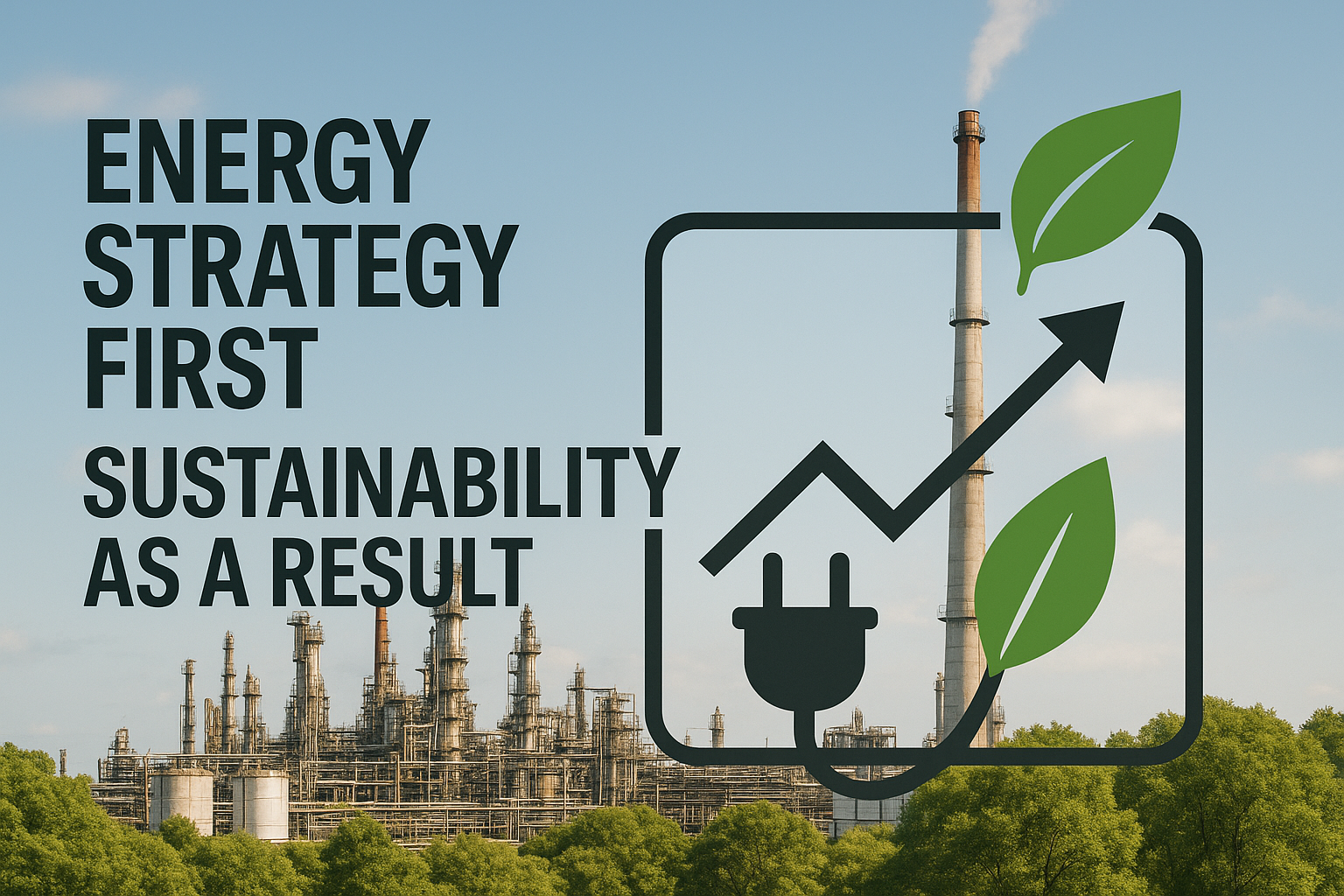If you lead an energy-intensive plant, you already know decarbonization is no longer a nice-to-have—it is a direct lever on competitiveness. According to McKinsey, a 10% increase in production efficiency can drive a 4% reduction in emissions intensity—a margin that often determines whether you meet corporate climate targets or pay for excess allowances.
Rising carbon prices, tightening regulations, and customer scrutiny are converging with volatile feedstock costs to squeeze margins. At the same time, front-line operations are inundated with sensor data that often remains idle in historians. The opportunity—and the imperative—is to turn that data into real-time action that trims carbon while improving production economics.
Artificial intelligence has evolved rapidly to meet that need. Early projects focused on dashboards and monthly reports. Today’s industrial AI goes further, learning plant-specific operations in real time, writing optimal setpoints back to the distributed control system (DCS), and closing the loop without constant manual tuning.
The following four strategies reveal how to harness industrial AI for more sustainable operations. Mastering these approaches will position your plant not only to comply with tightening standards but to grow profits in an increasingly carbon-constrained world.
Use AI to Maximize Energy Efficiency Without Manual Tuning
When your plant’s heaters, chillers, and compressors run around the clock, even small inefficiencies multiply into large energy bills and carbon footprints. Traditional controls catch obvious waste but miss complex interactions between feed rates, ambient conditions, and equipment wear. Industrial AI learns directly from your historian data, spotting hidden patterns human teams often miss.
Reinforcement Learning (RL) continuously explores relationships between process variables and energy use, adjusting in real time. An RL controller never grows complacent—it benchmarks against thousands of scenarios and recalibrates when drift appears. If heat exchanger fouling raises fuel demand, the model compensates immediately, maintaining throughput while reducing excess firing.
In compression services, industrial AI balances suction pressure, valve position, and motor speed without compromising stability. The closed-loop optimization also guards against off-spec events by respecting quality constraints while delivering significant electricity savings and lower emissions.
Consider a cement kiln where fuel quality fluctuates hourly. By feeding operational data into an AI model, producers can reduce coal usage while safely blending alternative fuels. The payoff is lower fuel spend, fewer emissions permits, and more resilient operations, without forcing your team to chase every loop manually.
Optimize Feedstock Blending and Crude Selection
When the composition of a feed shifts, so does its carbon footprint. A heavier crude with higher sulfur or metals loads demands more hydrogen, generates extra coke, and drives up CO₂ per barrel. You feel that impact immediately in fuel expense, flare events, and emissions reporting. Feedstock decisions—often made days before material enters the unit—present one of the fastest levers for decarbonization.
AI models give you the foresight that traditional linear models cannot. By ingesting years of operating data, sample results, market differentials, and even ship-arrival schedules, reinforcement learning models map the nonlinear links between every crude slate, downstream constraint, and emissions KPI.
Once trained, the model operates like a digital twin, simulating hundreds of blend scenarios in real-time and flagging the combinations that deliver a margin while keeping carbon intensity low. These systems can then adjust cut points or swap cargos automatically, writing optimized targets back to the distributed control system every few minutes.
Blending is only as good as the data behind it, and that’s where integration hurdles appear. Many refineries still rely on legacy historians and proprietary protocols that were never built for high-frequency AI workloads. Bridging those environments often means layering secure APIs over existing assets. Data gaps—missing density readings, delayed sulfur concentration, inconsistent unit tags—further erode model confidence. Cleansing and contextualizing those streams is critical for success.
Cybersecurity is another constraint. Opening historian ports to cloud analytics widens the attack surface, so successful projects embed security by design with role-based access and on-premise inference. Once that foundation is in place, you can scale the same architecture across crude tanks, condensate splitters, and even bio-feed co-processing lines.
The pay-off is tangible. Plants that have adopted AI-driven blending tools report reductions in flare volume and measurable drops in Scope 1 emissions because unstable combustion events are avoided. AI-based scheduling also steers high-carbon feeds away from periods when power grid intensity peaks, further trimming Scope 2 impact.
From an economic standpoint, the same optimization balances crude discounts, hydrogen cost, and carbon price exposure in a single objective function. That lets you defend profitability while stepping down your emissions trajectory, without waiting for the next major turnaround or capital project.
Unlock Emissions Reductions in Hard-to-Model Units
If you run a fluid catalytic cracker, reformer, or hydrocracker, you already know how quickly small disturbances trigger excess fuel use and emissions. Traditional advanced process control (APC) solutions lean on linearized steady-state assumptions; when feed quality shifts or ambient conditions swing, those models lose accuracy and operators end up chasing setpoints instead of optimizing them. Simulators struggle for the same reason—they cannot reflect such nonlinear behavior in real time.
These units are nonlinear and multivariable by design. Temperatures, pressures, catalyst activity, and feed composition interact in ways that defy simple cause-and-effect logic. A tiny change in riser temperature on an FCC, for instance, can ripple through regeneration, cyclone pressure drop, and wet-gas compressor load, pushing CO₂ and NOx well above permit limits. Relying solely on operator intuition or first-principles simulators forces a safety margin that sacrifices efficiency—and with it, emissions performance.
AI techniques rooted in deep learning close that gap. An adaptive model ingests years of historian data and live sensor values, then updates its internal representation every few seconds. Reinforcement learning controllers test thousands of virtual scenarios before writing a single new setpoint, letting the plant learn optimal responses without waiting for human trial-and-error.
Because the model never stops learning, it captures catalyst deactivation, fouling trends, and seasonal swings automatically, preventing the performance drift that plagues traditional approaches.
You also gain foresight. By detecting patterns that precede high flue-gas opacity or rising hydrogen make, the model recommends corrective moves minutes—or even hours—before an operator would normally react. Industry experience has shown significant reductions in unplanned downtime and energy efficiency improvements, resulting in lower direct emissions for complex units. Those numbers emerge because the AI maintains tighter constraints around optimal operating envelopes, driving steadier combustion and fewer off-spec products.
Handling thousands of variables in real time might sound computationally heavy, yet modern GPU-accelerated platforms execute RL policies within the millisecond cycles required by a distributed control system. Data security remains intact: the model can run on-premises, reading live tags and writing optimal setpoints back to the DCS without exporting raw plant data to the cloud. In practice, that means you see tangible carbon reductions while production stays on target—no added manual tuning, no lost throughput.
Mastering these hard-to-model units is a pivotal step in your decarbonization roadmap. Once they run at peak efficiency around the clock, broader, carbon-aware optimization across the entire site becomes far easier.
Enable Real-Time Carbon-Aware Optimization
You already tune furnaces, compressors, and boilers for energy efficiency, yet the carbon footprint of those same assets still swings hour by hour. Grid mix, production rate, feed quality, and even weather shift the emissions intensity of every unit of energy you consume. AI closes this visibility gap by learning how your operations respond to both internal and external carbon signals, steering them in real time toward the lowest possible Scope 1 and 2 impact.
Reinforcement learning controllers stream historian, sensor, and market data through a single model that predicts the carbon cost of each control move. When the grid relies more on fossil fuels, the model automatically adjusts equipment usage patterns. As renewable supply rises, it safely increases electric loads to protect throughput. Every adjustment is written back to the DCS so operators see carbon and production KPIs together.
The model tracks equipment-level energy flows, providing continuous emissions inventories without manual spreadsheets. This foundation supports carbon-aware scheduling, allocating energy-intensive tasks to the cleanest upcoming windows. Plants using this approach report significant drops in indirect emissions while maintaining production. The economics work because lower-carbon hours often coincide with off-peak tariffs.
AI quantifies trade-offs in advance: if reducing a heater’s firing rate saves CO₂ but risks yield loss, the model flags the exact break-even point that justifies the move. Early adopters are embedding carbon-aware optimization into daily workflows with impressive results. The path starts with your existing data streams and creates a system that safeguards throughput, maintains compliance, and empowers operators to manage carbon without added complexity.
Why Closed Loop AI Optimization (AIO) is the Missing Link
In the industrial sector, vast amounts of valuable data are often collected but not fully leveraged, leaving a gap between potential insights and actionable results. Many industrial plants gather data but struggle to convert it into meaningful, real-time decision-making improvements. This is where Imubit’s Closed Loop AI Optimization (AIO) enters the picture, transforming passive data gathering into active, intelligent decision-making systems that can significantly enhance efficiency and sustainability.
The dual benefit of using AIO is clear: it helps cut carbon emissions while simultaneously boosting operational performance. For example, in the refining industry, AIO can optimize systems to reduce energy consumption and improve yield, translating to lower carbon emissions per unit of production. This efficiency not only contributes to sustainability goals but also drives profitability by lowering costs and enhancing production output.
For plant leaders aiming to achieve decarbonization targets without sacrificing profitability, embracing Imubit’s Closed Loop AI Optimization solution provides a path forward that is both proven and scalable. By bridging the gap between data collection and actionable intelligence, AIO offers a robust solution for those seeking to make meaningful strides in industrial decarbonization while enhancing competitive edge.
Now is the time to consider a complimentary AIO assessment to fully realize the potential of this transformative technology. This is the forward-thinking approach process industry leaders need to meet the demands of tomorrow’s challenges.




